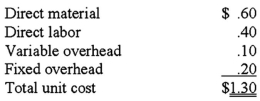Cohasset Company currently manufactures all component parts used in the manufacture of various hand tools.Hurley Division produces a steel handle used in three different tools.The budget for these handles is 120,000 units with the following unit cost.  Ironwood Division purchases 20,000 handles from Hurley Division and completes the hand tools.An outside supplier,R & M Steel,has offered to supply 20,000 units of the handle to Ironwood Division for $1.25 per unit.Hurley currently has idle capacity that cannot be used.If Cohasset would like to develop a range of transfer prices,what would be the maximum transfer price that Ironwood would be willing to pay?
Ironwood Division purchases 20,000 handles from Hurley Division and completes the hand tools.An outside supplier,R & M Steel,has offered to supply 20,000 units of the handle to Ironwood Division for $1.25 per unit.Hurley currently has idle capacity that cannot be used.If Cohasset would like to develop a range of transfer prices,what would be the maximum transfer price that Ironwood would be willing to pay?
Definitions:
Nonoperating Activities
Transactions or events that fall outside the primary operations of a business, impacting the firm's financials but not related to its core operations.
Revenues
The complete revenue accrued from the core business activities through selling goods or services.
Secondary Operations
Processes that are performed after the primary manufacturing or production process to add value to a product, such as finishing, painting, or assembly.
Periodic Inventory System
An inventory accounting system where stock levels and cost of goods sold are determined at the end of an accounting period through a physical count.
Q25: Examples of pressures that can lead to
Q28: Chang Inc.has developed the following unit costs
Q39: Lynndorf Corporation is a manufacturer of tables
Q50: One advantage of nonfinancial measures is that
Q53: John steals an old, battered bicycle that
Q61: Given the following information in standard costing:
Q66: Which of these variances is least significant
Q69: Tyro has the right to drive across
Q77: In the general model,an efficiency variance is
Q79: Cohasset Company currently manufactures all component parts